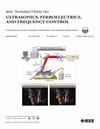利用行-列寻址阵列的4维矢量多普勒成像
IF 3
2区 工程技术
Q1 ACOUSTICS
IEEE transactions on ultrasonics, ferroelectrics, and frequency control
Pub Date : 2024-12-17
DOI:10.1109/TUFFC.2024.3519179
引用次数: 0
摘要
高时间分辨率的大孔径4-D血流多普勒成像仍然是一个重要的挑战。与传统的矩阵阵列策略不同,我们提出了一种使用$128+128$行-列寻址(RCA)阵列和256通道超声平台的4维超声矢量多普勒(4D-UVD)成像方法。该方法将超快二维平面波传输序列与最小二乘多角度多普勒速度估计相结合。在抛物流的模拟和模拟实验中验证了该方法的准确性。仿真结果表明,估计速度的均方根误差(RMSE)小于15%. In the phantom experiments, the relative mean bias $\overline {B}$ and the standard deviation (SD) $\overline {\sigma }$ of the velocity profiles are less than 7.9% and 6.9%, respectively, suggesting a high estimated precision. Furthermore, in vivo feasibility of the approach was demonstrated in the human carotid artery. The blood flow velocity of the carotid artery was continuously measured over seven cardiac cycles at a 1-kHz volume rate. The fluctuations of the estimated mean and peak velocities were highly consistent with the pulse waves measured using a gating pulse sensor, yielding synchronization coefficients of 0.85 and 0.87, respectively. It is thus concluded that the proposed method can achieve a large aperture 4-D vector flow imaging with high temporal resolution using an RCA probe.本文章由计算机程序翻译,如有差异,请以英文原文为准。
4-D Vector Doppler Imaging Using Row-Column Addressed Array
Large aperture 4-D blood flow Doppler imaging with high temporal resolution remains an important challenge. Different from the conventional matrix-array strategy, we proposed a 4-D ultrasound vector Doppler (4D-UVD) imaging method using a $128+128$ row-column addressed (RCA) array and a 256-channel ultrasound platform. This method integrates ultrafast 2-D plane wave transmission sequence and least-squares multiangle Doppler velocity estimator. The accuracy of the proposed method was evaluated in both simulations and phantom experiments of parabolic flow. The simulated result shows that the root-mean-squared error (RMSE) of estimated velocity is less than 15%. In the phantom experiments, the relative mean bias $\overline {B}$ and the standard deviation (SD) $\overline {\sigma }$ of the velocity profiles are less than 7.9% and 6.9%, respectively, suggesting a high estimated precision. Furthermore, in vivo feasibility of the approach was demonstrated in the human carotid artery. The blood flow velocity of the carotid artery was continuously measured over seven cardiac cycles at a 1-kHz volume rate. The fluctuations of the estimated mean and peak velocities were highly consistent with the pulse waves measured using a gating pulse sensor, yielding synchronization coefficients of 0.85 and 0.87, respectively. It is thus concluded that the proposed method can achieve a large aperture 4-D vector flow imaging with high temporal resolution using an RCA probe.
求助全文
通过发布文献求助,成功后即可免费获取论文全文。
去求助
来源期刊
CiteScore
7.70
自引率
16.70%
发文量
583
审稿时长
4.5 months
期刊介绍:
IEEE Transactions on Ultrasonics, Ferroelectrics and Frequency Control includes the theory, technology, materials, and applications relating to: (1) the generation, transmission, and detection of ultrasonic waves and related phenomena; (2) medical ultrasound, including hyperthermia, bioeffects, tissue characterization and imaging; (3) ferroelectric, piezoelectric, and piezomagnetic materials, including crystals, polycrystalline solids, films, polymers, and composites; (4) frequency control, timing and time distribution, including crystal oscillators and other means of classical frequency control, and atomic, molecular and laser frequency control standards. Areas of interest range from fundamental studies to the design and/or applications of devices and systems.

 求助内容:
求助内容: 应助结果提醒方式:
应助结果提醒方式:


